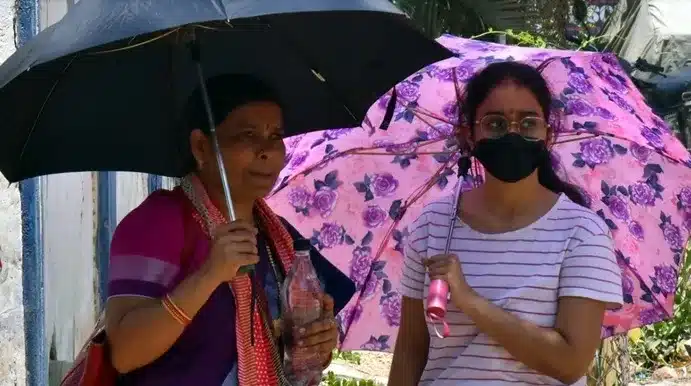What’s in today’s article?
- Why in News?
- What is Heatstroke?
- Key highlights of the guidelines
Why in News?
The Union Health Ministry has issued standardised guidelines for confirming heatstroke and heat-related deaths in the country.
What is Heatstroke?
- About
- A heat stroke or sunstroke is the result of overheating of the body as a result of exposure to high temperatures and humidity, or due to prolonged physical exertion at high temperatures.
- A heat stroke is considered to be a medical emergency that requires prompt attention.
- Persons suffering from heat exhaustion experience fatigue, dizziness, headache, nausea, vomiting, hypotension (low blood pressure) and tachycardia (increased heart rate).
- Criteria for heatstroke
- Body temperatures of 40°C i.e. 104°F or more along with delirium, seizures or coma. This is a potential fatal condition.
- Heatstroke deaths in India

- As per the analysis of the National Crime Records Bureau data, more than 11,000 people died due to heat stroke in India between 2012 and 2021.
- Steps taken by the govt
- A National Action Plan on Heat-Related Illness was released by the Health Ministry in July 2021.
- It outlines the health challenges posed by heat waves and how to deal with them.
- The India Cooling Action Plan (ICAP) aims to reduce the impact of heat by providing sustainable cooling and thermal comfort for all by 2037-38.
- Steps to be taken if someone is suffering from the heat
- Move the person to a cool place under the shade
- Give water or a rehydrating drink (if the person is still conscious)
- Fan the person
- Consult a doctor if symptoms get worse or are long lasting or the person is unconscious
- Do not give alcohol, caffeine or aerated drink
- Cool the person by putting a cool wet cloth on his/her face/body
- Loosen clothes for better ventilation
Key highlights of the guidelines
- Need for the guidelines
- In 2013–22, compared with 1991–2000, the estimated average annual heat-related mortality increased by 85%.
- It is driven by both warming and changing demographics, globally.
- If global mean temperature continues to increase toward 2°C of pre-industrial levels, annual heat-related deaths are projected to increase by 370% by mid-century, assuming no substantial progress on adaptation.
- In this context, we must strengthen our understanding and surveillance of heat-health.
- Prepared by
- The guidelines are prepared by the National Programme on Climate Change and Human Health (NPCCHH) and National Centre for Disease Control (NCDC).
- In 2013–22, compared with 1991–2000, the estimated average annual heat-related mortality increased by 85%.
- Aim
- The set of guidelines is aimed at helping hospitals become aware of the criteria to label a death as heat-related/ heat stroke and bring in evidence-based medical decision-making processes.
- Decision to conduct an autopsy
- As per the guidelines, decision to conduct an autopsy should be based on the circumstances of the death, the age of the deceased, and the available resources.
- The collection of blood, urine, etc., for toxicological examination is highly desirable if the condition of the body allows it.
- Highlights the challenges in diagnosis of heat-related deaths
- The post-mortem diagnosis of heat-related deaths poses many challenges. These includes:
- Pre-terminal or terminal body temperatures are frequently unavailable,
- The autopsy findings are non-specific and depend upon the duration of survival after exposure,
- Diagnosis of hyperthermia is mostly dependent on the scene investigation,
- Hyperthermia is a condition where the body’s temperature is abnormally high due to the body’s inability to regulate heat from the environment.
- The circumstances of death, and the reasonable exclusion of alternative causes of death.
- Also, the autopsy is not mandatory in heat-related deaths.
- The post-mortem diagnosis of heat-related deaths poses many challenges. These includes:
Q.1. What is the National Crime Records Bureau (NCRB)?
The National Crime Records Bureau (NCRB) is an organization that collects, analyzes, and disseminates crime data in India. It was established in 1986 under the Ministry of Interior and is headquartered in New Delhi. The NCRB’s primary goal is to improve decision-making and planning processes by using crime-related information.
Q.2. What is National Centre for Disease Control (NCDC)?
The National Centre for Disease Control is an institute under the Indian Directorate General of Health Services, Ministry of Health and Family Welfare. It was established in July 1963 for research in epidemiology and control of communicable diseases and to reorganize the activities of the Malaria Institute of India.
Source: Health Ministry issues guidelines for confirming heatstroke and heat-related deaths | NDMA | PIB | India Today
Last updated on December, 2025
→ Check out the latest UPSC Syllabus 2026 here.
→ Join Vajiram & Ravi’s Interview Guidance Programme for expert help to crack your final UPSC stage.
→ UPSC Mains Result 2025 is now out.
→ UPSC Notification 2026 is scheduled to be released on January 14, 2026.
→ UPSC Calendar 2026 is released on 15th May, 2025.
→ The UPSC Vacancy 2025 were released 1129, out of which 979 were for UPSC CSE and remaining 150 are for UPSC IFoS.
→ UPSC Prelims 2026 will be conducted on 24th May, 2026 & UPSC Mains 2026 will be conducted on 21st August 2026.
→ The UPSC Selection Process is of 3 stages-Prelims, Mains and Interview.
→ UPSC Result 2024 is released with latest UPSC Marksheet 2024. Check Now!
→ UPSC Prelims Result 2025 is out now for the CSE held on 25 May 2025.
→ UPSC Toppers List 2024 is released now. Shakti Dubey is UPSC AIR 1 2024 Topper.
→ UPSC Prelims Question Paper 2025 and Unofficial Prelims Answer Key 2025 are available now.
→ UPSC Mains Question Paper 2025 is out for Essay, GS 1, 2, 3 & GS 4.
→ UPSC Mains Indian Language Question Paper 2025 is now out.
→ UPSC Mains Optional Question Paper 2025 is now out.
→ Also check Best IAS Coaching in Delhi

















